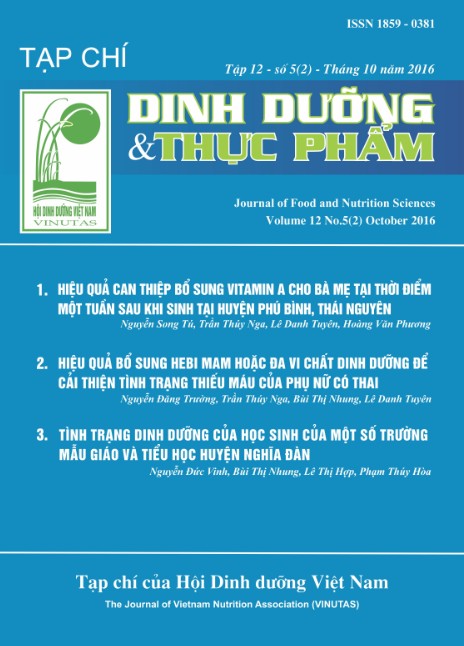EFFICACY OF A DAILY INTAKE OF A READY-TO- USE SUPPLEMENTARY FOOD (HEBI-MAM) AMONG VIETNAMESE PREGNANT WOMEN ON THEIR MATERNAL ANEMIA STATUS
Main Article Content
Abstract
Objectives: The objective of this study was to test the effect of a daily ready-to-usesupplement foods (RUSF) fortified with 21 micronutrients providing 225 kcal (Hebi-Mam)
on hemoglobin status of pregnant women in 10 communes, An Lao district, Hai Phong
city. Subjects and methods: A group of 398 pregnant women with gestational ages of 6 to
16 wk were enrolled in a randomized controlled trial, in which study women in 3 groups
received at least 20 wk of either iron (58 mg) and folic acid (400 µg) supplementation or
multiple micronutrient supplementation including 30 mg iron and 400 µg folic acid or
Hebi-Mam including 30 mg iron and 400 µg folic acid. Hemoglobin was measured at
baseline (6-16 gestational weeks) and at near term (36 gestational weeks) by cyanmethemoglobin method. Results: The three interventions were equally effective in increasing
hemoglobin concentrations, with a mean increase of 3.3 g/l in iron/folate group, 2.7g/l in
multiple micronutrient supplementation group and 3.1 g/L in food supplement group
(p<0.01). The prevalence of anemia was 26.1%, 24.8% and 24.5%, respectively. Factors
found to be important predictors of hemoglobin improvement were baseline hemoglobin
(p<0,001), gestational age at baseline (p<0.001), and ferritin < 15 mcg/l (p<0.01). Conclusion and recommendation: The RUSF Hebi-Mam was as effective as the multiple micronutrient tablet and iron/folate tablet in maintaining hemoglobin status during pregnancy.
Therefore, this locally produced RUSF Hebi-Mam could become a promising strategy to
be included into maternal intervention programs in Vietnam, to contribute to the optimal
nutrient intake and to improve nutritional status of women during the critical period of
pregnancy.
Keywords
Pregnant women, anemia, multiple micronutrient, supplementation food
Article Details
References
2. Viện Dinh dưỡng (2014), Đánh giá tình trạng thiếu máu, thiếu một số vi chất dinh dưỡng ở phụ nữ và trẻ em năm 2014. Hội nghị Công bố kết quả Tổng điều tra vi chất dinh dưỡng tháng 10 năm 2015, 2015.
3. Huỳnh Nam Phương và Phạm Thị Thúy Hòa (2009). Tình trạng dinh dưỡng và khẩu phần thực tế của phụ nữ có thai dân tộc Mường tại huyện Tân Lạc - Hòa Bình. Tạp chí Y tế Công cộng. 2009. 13(13), tr.46-50.
4. Bộ Y tế. Chiến lược Dinh dưỡng quốc gia 2011-2020, tầm nhìn 2030. Nhà xuất bản Y học, tháng 2/2012.
5. UNICEF. Tracking progress on child and maternal nutrition: A survival and development priority, 2009.
6. Suresh and Chandrashekara (2012). Sample size estimation and power analysis for clinical research studies. J Hum Reprod Sci. 2012 Jan-Apr; 5(1): 7-13
7. Choudhury N. et al (2012). Relative efficacy of micronutrient powders versus iron– folic acid tablets in controlling anemia in women in the second trimester of pregnancy, Food and Nutrition Bulletin, vol.33, no.2; 2012.
8. Trương Hồng Sơn (2012). Hiệu quả can thiệp cộng đồng bằng bổ sung sớm đa vi chất dinh dưỡng trên phụ nữ tại một số xã thuộc tỉnh Kom Tum và Lai Châu, Luận án Tiến sỹ Dinh dưỡng. 2012
9. WHO (2012). Guideline: Daily iron and folic acid supplementation in pregnant women. Geneva, World Health Organization, 2012
10.FAO/WHO (2004). Human vitamin and mineral requirements. A report of a joint
FAO/WHO expert consultation. Bangkok:
FAO/WHO; 2004.
11.WHO (2011). Haemoglobin concentrations for the diagnosis ofanaemia and assessment of severity. Vitamin and Mineral Nutrition Information System. Geneva, WorldHealth Organization, 2011 (WHO/NMH/NHD/MNM/11.1)
12.Yang Z, Huffman SL. (2011) Review of fortified food and beverage products for pregnant and lactating women and their impact on nutritional status. Matern Child Nutr. 7 Suppl 3:19-43
13.Mardones F, Urrutia MT, Villarroel L, Rioseco A, Castillo O, Rozowski J, Tapia JL, Bastias G, Bacallao J, Rojas I. (2008) Effects of a dairy product fortified with multiple micronutrients and omega-3 fatty acids on birth weight and gestation duration in pregnant Chilean women. Public Health Nutr. 11(1):30-40.
14.Choudhury N, Aimone A, Hyder SM, Zlotkin SH. (2012) Relative efficacy of icronutrient powders versus iron-folic acid tablets in controlling anemia in women in the second trimester of pregnancy. Food & Nutrition Bulletin;33(2):142–9.
15.Hernández Cabrera A, García Guerra A, Domínguez CP, García Feregrino R, Neufeld LM. (2008) Effect of three supplements with identical micronutrient content on anemia in pregnant Mexican women. FASEB Journal ;22:Abstract No:677.8.
16.Haider BA, Bhutta ZA. (2015) Multiplemicronutrient supplementation for women during pregnancy (Review). Cochrane Database Syst Rev. 1;(11):CD004905.
Similar Articles
- Master of Science Van Le NGUYEN, Thuy Nga TRAN, Nam Phuong HUYNH, Khanh Van TRAN, Thi Lan Phuong NGUYEN, Anh Hoa LE, Van Thanh Tung LE, Thi Thu Hang DINH, Huu Chinh NGUYEN, NUTRITIONAL STATUS AND AND ITS ASSOCIATED FACTORS AMONG CHILDREN AGED 24-59 MONTHS IN PHU LUONG DISTRICT, THAI NGUYEN PROVINCE IN 2022 , Vietnam Journal of Nutrition & Food: Vol. 20 No. 6 (2024): SCIENTIFIC CONFERENCE OF THE NATIONAL INSTITUTE OF NUTRITION, 2024
- Minh Anh Nguyễn, Tuyet Mai TRUONG, Thi Thu Trang TRAN, Truong Duy DANG, Thi Ha Phuong NGO, Thi Ho Ngoc VUONG, Thi Hang HOANG, MALNUTRITION STATUS AND ASSOCIATED FACTORS AMONG CHILDREN UNDER 5 YEARS OF AGE IN LANG CHANH DISTRICT, THANH HOA PROVINCE, 2023 , Vietnam Journal of Nutrition & Food: Vol. 21 No. 4 (2025)
- Cử nhân Phuong Thao TRAN, Huu Chinh NGUYEN, Van Tuoc BUI, Nguyen Phuong Linh HOANG, Thi Huyen Trang NGUYEN, Thuy Tien NGUYEN, Thi Nhung BUI, Do Van Anh NGUYEN, ANTHROPOMETRIC PATTERNS AND NUTRITIONAL STATUS OF CHILDREN IN TWO PRESCHOOLS IN NINH BINH PROVINCE IN 2022 , Vietnam Journal of Nutrition & Food: Vol. 20 No. 6 (2024): SCIENTIFIC CONFERENCE OF THE NATIONAL INSTITUTE OF NUTRITION, 2024
- Thi Thu Lieu NGUYEN, Thi My Thuc LUU, Luong Thu Anh NGUYEN, Thi Thanh Truc LE, Thi Ngoc Giang NGUYEN, NUTRITIONAL STATUS OF HOSPITALIZED CHILDREN DURING 2019-2024 AND RELATED FACTORS: A SCOPING REVIEW , Vietnam Journal of Nutrition & Food: Vol. 21 No. 1 (2025)
You may also start an advanced similarity search for this article.


